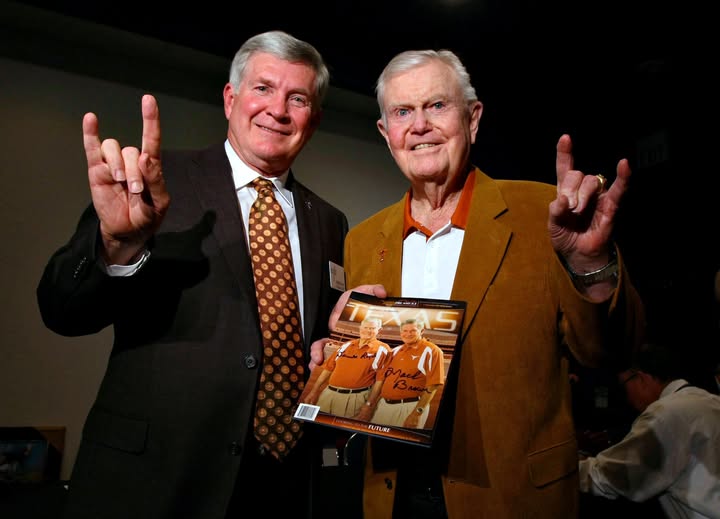Darrell Royal’s name is etched into the annals of college football history not just as a winning coach, but as a transformative figure whose legacy still reverberates through the University of Texas and the sport itself. Over a span of two decades from 1957 to 1976, Royal was the embodiment of Longhorn football, defining an era that combined innovation, discipline, integrity, and sustained excellence. His tenure at Texas was more than just about championships; it was about building a culture of toughness, class, and timeless values.
When Royal arrived in Austin in 1957, the University of Texas football program was in disarray. The Longhorns had endured six straight losing seasons, and morale was low. In walked a relatively young 32-year-old coach with a sharp mind, a steady hand, and a fierce competitive streak. Royal had played quarterback at the University of Oklahoma and had coached under Bud Wilkinson, inheriting not just a love for the game but also a belief in systems, preparation, and discipline. His very first season at Texas turned heads: the Longhorns went 6-4-1 and earned a berth in the Sugar Bowl. That was just the beginning of a historic turnaround.
Darrell Royal would go on to win 167 games as head coach at Texas, still the most in school history. He never had a losing season in 20 years, a stunning feat in the world of college football where injuries, recruitment, and competition can derail even the best-laid plans. Under his guidance, the Longhorns won three national championships (1963, 1969, and 1970) and captured 11 Southwest Conference titles. Yet, Royal’s greatness wasn’t just in the numbers. It was in the culture he instilled and the innovation he brought.
One of the key innovations associated with Royal is the implementation of the wishbone offense. Alongside offensive coordinator Emory Bellard, Royal introduced the wishbone at Texas in 1968. The offense was built around a triple-option running attack, emphasizing deception, quick decision-making, and punishing ground gains. It revolutionized the college game, confused opponents, and played to Texas’s strengths. After a shaky debut, the wishbone helped Texas go undefeated in 1968 and 1969, culminating in one of the most famous games in college football history: the 1969 “Game of the Century” against Arkansas.
On December 6, 1969, with President Richard Nixon in attendance, the #1-ranked Longhorns met the #2-ranked Razorbacks in a showdown for the ages. Texas came from behind in dramatic fashion to win 15-14, securing a national title and solidifying Royal’s legacy as a master tactician and fearless leader. That game not only epitomized the intensity of the sport but also highlighted Royal’s poise under pressure and his ability to inspire belief in his players when it mattered most.
Royal was a player’s coach, but he was also a stickler for discipline. He expected his athletes to conduct themselves with integrity, both on and off the field. His now-famous “Three Rules” encapsulate his coaching philosophy: “1. Be honest. 2. Be loyal. 3. Do the right thing.” Simple, yes—but deeply effective. Royal wasn’t interested in gimmicks or shortcuts. He wanted young men who respected the game and respected themselves. He often said, “Football doesn’t build character, it reveals it,” and under his leadership, players were expected to live that principle every day.
Despite his tough approach, Royal was beloved by his players. He mentored them not just as athletes but as men. Many of his former players went on to become successful coaches, businessmen, and community leaders. To them, he wasn’t just a coach—he was a father figure, a mentor, and a lifelong example of how to lead with dignity. His influence extended beyond football, as he encouraged education, responsibility, and humility.
Royal’s leadership also extended into areas of social progress, albeit quietly and without seeking headlines. In an era when racial integration was still controversial in many parts of the South, Royal played a critical role in integrating the Texas football program. He recruited Julius Whittier, who in 1970 became the first African American to letter for the Longhorns. While others may have shied away from such bold moves, Royal stood firm in his belief that character, not color, defined a man. His understated courage in this area helped modernize the program and opened doors for generations to come.
Another remarkable aspect of Royal’s coaching career is that he was never caught up in scandal or controversy. In a profession often marred by NCAA investigations and win-at-all-costs mentalities, Royal stood as a model of integrity. He valued loyalty over flash, substance over hype. It’s no surprise that even after his coaching career ended, he remained a towering figure in Austin and throughout Texas.
When Royal retired from coaching in 1976, he left behind a legacy that was about far more than wins and losses. He served as the Texas athletic director for a time and remained deeply involved with the university. In 1996, the football stadium in Austin was renamed Darrell K Royal–Texas Memorial Stadium, a fitting tribute to the man who had done more than anyone to elevate the Longhorns to national prominence.
Even after retirement, Royal’s presence loomed large. He was a trusted advisor, a symbol of pride, and a beloved public figure across Texas. His words carried weight, and his opinions mattered to those in power. He continued to support the university and the team, mentoring coaches like Mack Brown, who revered Royal as both a friend and a guiding light.
Royal’s impact wasn’t limited to football. He and his wife Edith were generous philanthropists, supporting causes ranging from medical research to educational initiatives. In his later years, Royal battled Alzheimer’s disease, and the University of Texas established the Darrell K Royal Research Fund for Alzheimer’s Disease in his honor. The fund supports cutting-edge research and demonstrates yet again how Royal’s legacy extends beyond the field.
Darrell Royal passed away in 2012 at the age of 88. The outpouring of tributes that followed revealed just how deeply he had touched lives. Former players, coaches, politicians, and fans from all walks of life shared stories of his wisdom, humor, humility, and unshakable character. For many, he was not just a football coach—he was Texas. A steady hand in turbulent times, a beacon of excellence, and a reminder of what leadership at its best can look like.
Even now, his lessons endure. Coaches still quote his maxims. Players still study his strategies. Fans still recall the glory years he delivered. And Longhorn football still bears the imprint of his spirit and philosophy. The burnt orange and white, the “Hook ‘Em Horns,” the fight songs, and the pride of Texas football—all of it echoes back to Darrell Royal.
Perhaps what makes Royal so revered is that he never sought the spotlight. He believed in doing the work, showing up every day, and staying humble. In a profession where ego often overshadows substance, Royal let his actions do the talking. And those actions, decade after decade, shaped one of the most successful and respected programs in the history of college football.
Darrell Royal’s story is not just a sports story. It’s an American story—of rising from humble beginnings, embracing opportunity, striving for excellence, and leading with character. His 20 years at the helm of Texas Longhorns football were about far more than touchdowns and trophies. They were about building something lasting, something meaningful. And in that, Darrell Royal succeeded in ways that statistics alone can never fully capture.



